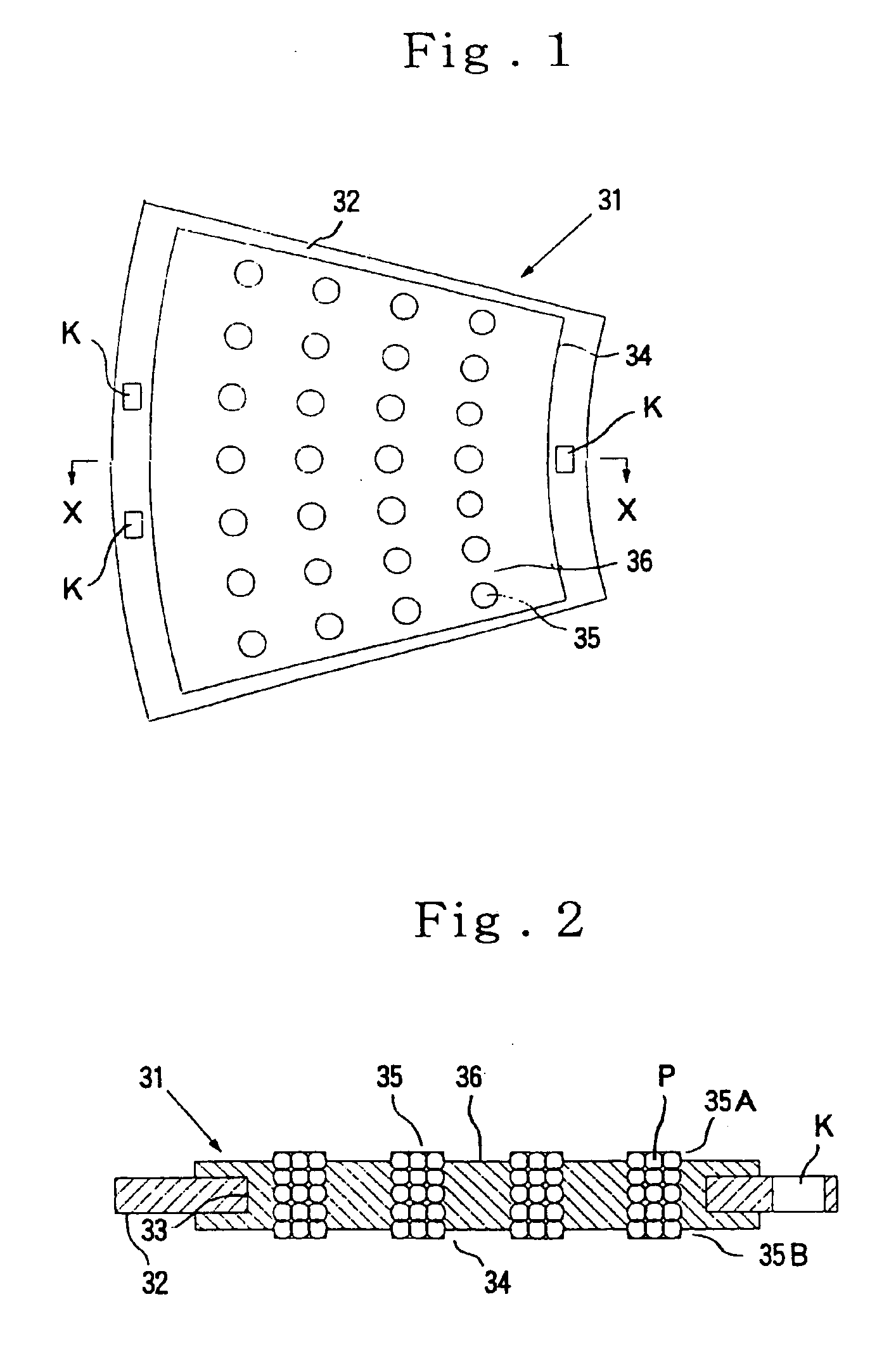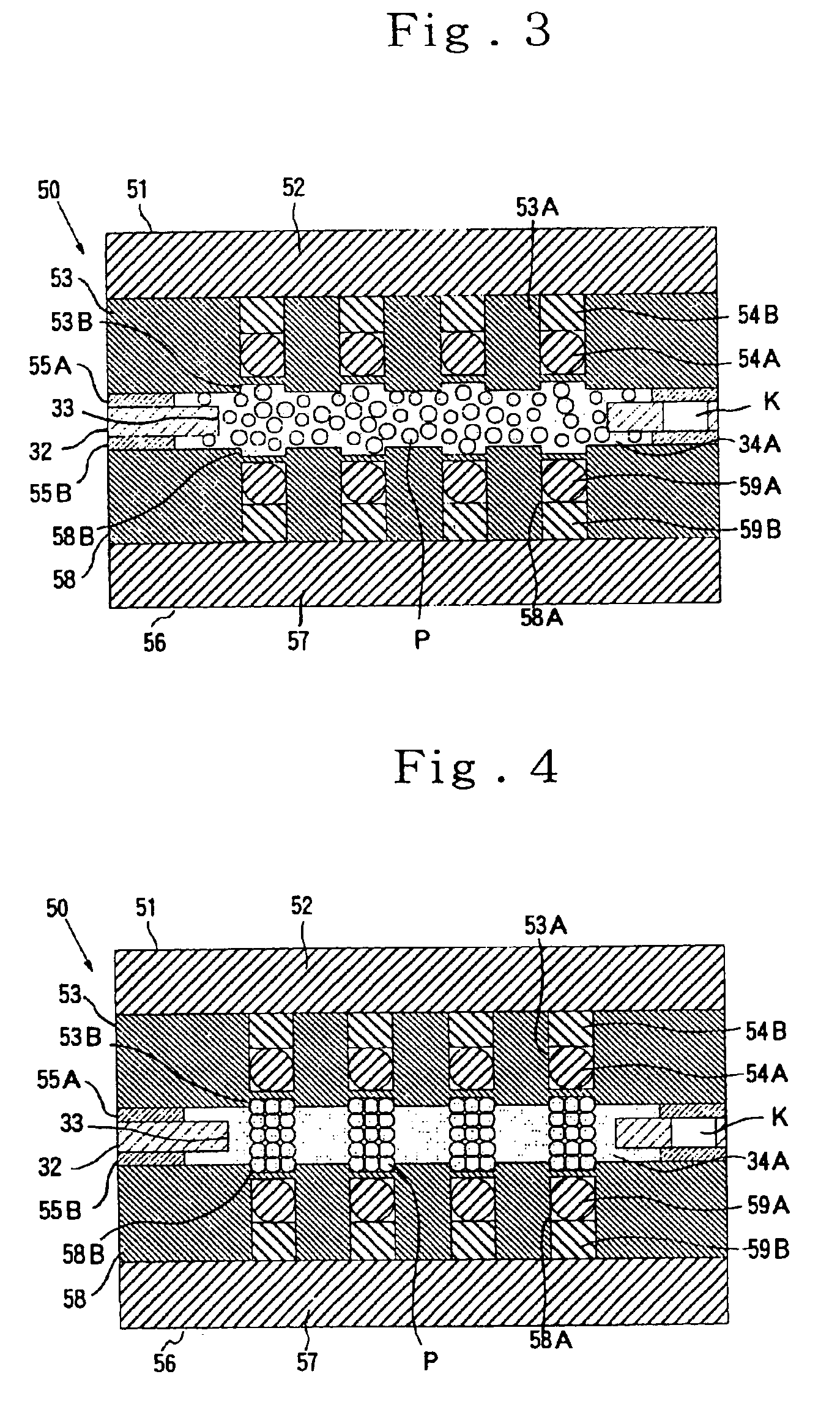Anisotropic conductive sheet and wafer inspection device
- Summary
- Abstract
- Description
- Claims
- Application Information
AI Technical Summary
Benefits of technology
Problems solved by technology
Method used
Image
Examples
production example 1
[Production Example 1 of Mold]
A brass plate having a thickness of 3.0 mm was provided, a plurality of recesses for receiving a magnetic member, which each had a circular section whose diameter was 1.0 mm and depth was 2.7 mm, were formed in one surface of such a non-magnetic base plate by a drilling machine at a pitch of 2 mm in an X—X direction (the direction meaning a direction corresponding to the X—X direction in FIG. 1 or FIG. 6; the same shall apply hereinafter), and a plurality of recesses for forming a projected portion, which each had a circular section whose diameter was 0.8 mm and depth was 0.2 mm, were formed in the other surface of the non-magnetic base plate at a pitch of 2 mm in the X—X direction, thereby producing a non-magnetic base plate. A spherical magnetic member made of iron having a diameter of 1.0 mm was arranged in each of the recesses for receiving the magnetic member in this non-magnetic base plate, and a columnar lid member having a thickness of 1.7 mm an...
production example 2
[Production Example 2 of Mold]
An iron plate having a thickness of 6 mm was provided, and one surface of this iron plate was subjected to a photoetching treatment using a dry film resist and ferric chloride, thereby producing an intermediate in which a plurality of disk-like ferromagnetic substance layers each having a thickness of 0.1 mm and a diameter of 0.5 mm had been integrally formed at a pitch of 1.27 mm in the X—X direction in a ferromagnetic base plate made of iron having a thickness of 5.9 mm.
Non-magnetic substance layer having a thickness of 0.2 mm was formed at other area than the ferromagnetic substance layers in said one surface of the intermediate by using a resist, thereby making a top force. A bottom force was made in the same manner as in the production of the top force to produce a mold of the construction shown in FIG. 5. This mold is referred to as “Mold b”.
example 1
An insulating sheet body composed of a glass fiber-reinforced epoxy resin (modulus of elasticity: 2×109 Pa; coefficient of linear thermal expansion: 1.5×10−5 K−1; saturation magnetization: 0 wb / m2) and having a thickness of 0.4 mm, in which a great number of through-holes each having a circular section of 1.8 mm in a diameter had been formed at a pitch of 2.0 mm in the X—X direction, was produced, and 2 spacers composed of stainless steel (SUS-304) having a thickness of 0.6 mm, in which a great number of through-holes each having a circular section of 1.95 mm in a diameter had been formed at a pitch of 2.0 mm in the X—X direction, were produced.
On the other hand, 6 g of conductive particles having a number average particle diameter of 120 μm were added to and mixed with 16 g of addition type liquid silicone rubber, “KE-2000-30” (product of Shin-Etsu Chemical Co., Ltd.), thereby preparing a molding material for molding an elastic anisotropically conductive film. As the conductive par...
PUM
 Login to View More
Login to View More Abstract
Description
Claims
Application Information
 Login to View More
Login to View More - R&D
- Intellectual Property
- Life Sciences
- Materials
- Tech Scout
- Unparalleled Data Quality
- Higher Quality Content
- 60% Fewer Hallucinations
Browse by: Latest US Patents, China's latest patents, Technical Efficacy Thesaurus, Application Domain, Technology Topic, Popular Technical Reports.
© 2025 PatSnap. All rights reserved.Legal|Privacy policy|Modern Slavery Act Transparency Statement|Sitemap|About US| Contact US: help@patsnap.com



